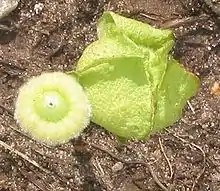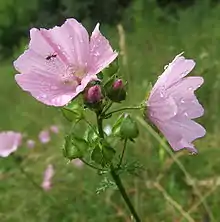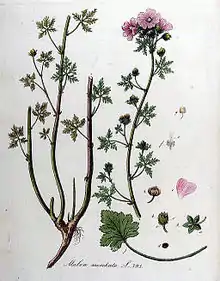Malva moschata
Malva moschata, the musk mallow or musk-mallow,[1] is a species of flowering plant in the family Malvaceae, native to Europe and southwestern Asia, from Spain north to the British Isles and Poland, and east to southern Russia and Turkey.[2][3][4][5] Growing to 60 cm (24 in) tall, it is a herbaceous perennial with hairy stems and foliage, and pink saucer-shaped flowers in summer.

| Malva moschata | |
|---|---|
 | |
| Flowers | |
| Scientific classification | |
| Kingdom: | Plantae |
| Clade: | Tracheophytes |
| Clade: | Angiosperms |
| Clade: | Eudicots |
| Clade: | Rosids |
| Order: | Malvales |
| Family: | Malvaceae |
| Genus: | Malva |
| Species: | M. moschata |
| Binomial name | |
| Malva moschata | |
Description
The leaves are alternate, 2–8 cm long and 2–8 cm broad, palmately lobed with five to seven lobes; basal leaves on the lower stem are very shallowly lobed, those higher on the stems are deeply divided, with narrow, acuminate lobes. The flowers are produced in clusters in the leaf axils, each flower 3.2–5 cm diameter, with five bright pink petals with a truncated to notched apex; they have a distinctive musky odour. The fruit is a disc-shaped schizocarp 3–6 mm diameter, containing 10–16 seeds, the seeds individually enclosed in a mericarp covered in whitish hairs. It has a chromosome count of 2n=42.[4][5]
Ecology
It occurs on dry, but fertile soils at altitudes from sea level up to 1,500 m (4,900 ft). Natural hybrids with the closely related Malva alcea are occasionally found.[5]

Cultivation and uses

Malva moschata is widely grown as an ornamental plant for its attractive scented flowers, produced for a long period through the summer. Several cultivars have been selected for variation in flower colour, including 'Rosea' with dark pink flowers.[6][7] The cultivar 'Alba' (white flowered) has gained the Royal Horticultural Society's Award of Garden Merit.[8][9]
Leaves and flowers of muskmallow are common additions to "wild" salads. The seeds are also edible.
It has been introduced to and become naturalised in several areas with temperate climates away from its native range, including Scandinavia, New Zealand, and North America.[5][6][7]
References
- "BSBI List 2007". Botanical Society of Britain and Ireland. Archived from the original (xls) on 2014-10-23. Retrieved 2014-10-17.
- Flora Europaea: Malva moschata
- Med-Checklist: Malva moschata
- Flora of NW Europe: Malva moschata
- Blamey, M. & Grey-Wilson, C. (1989). Flora of Britain and Northern Europe. ISBN 0-340-40170-2
- Huxley, A., ed. (1992). New RHS Dictionary of Gardening. Macmillan ISBN 0-333-47494-5.
- Malva Pages: Musk Mallows (section Bismalva)
- "RHS Plant Selector - Malva moschata f. alba". Retrieved 19 July 2013.
- "AGM Plants - Ornamental" (PDF). Royal Horticultural Society. July 2017. p. 63. Retrieved 25 March 2018.